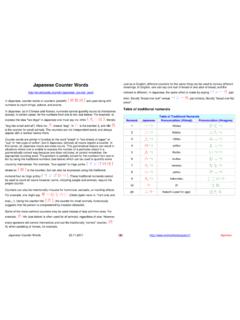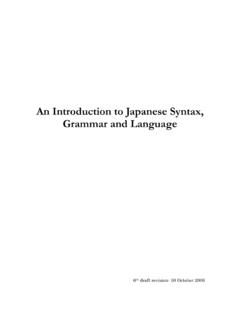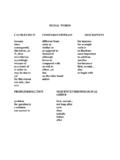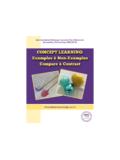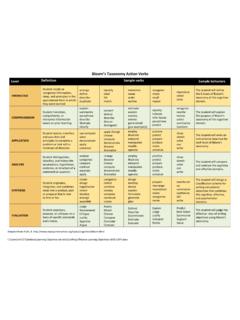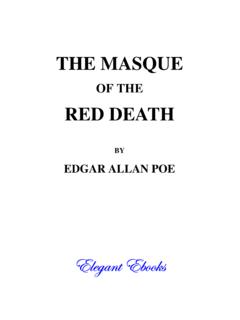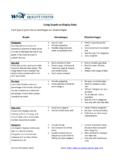Transcription of The most common Chinese characters in order of frequency
1 1/124 The most common Chinese characters in order of frequency All characters are presented in falling statistical order with the most commonly used characters first (ie from 1 to 3000). Alternative forms of characters are specified within parentheses in which case "F" marks full (or traditional) forms, "S" marks simplified (or modern) forms and "A" marks alternative forms (mostly special numerals).
2 Pronunciation is specified according to Pinyin and written within brackets "[..]". After each given pronunciation, a number of possible translations are listed. If a character corresponds closely to a somewhat longer word (usually a word that contains the character in question), the longer word is given in the list of translations marked with parentheses and a "=". After the translation of each character , example words containing the character are often listed these words are separated by semi commas. No guarantee is given that all the most common words are listed or that the given examples are very common .
3 Some of the listed pronunciations are less used than others, and in those cases translations and examples may lack. Grammatical particles, classifiers and other special translations are marked with hooks "<..>". Curly brackets "{..}" are mostly used when giving references to characters that are similar to the listed ones either in shape. This is to help you avoid miswriting/misreading. The same marking is also used for references to characters with similar meaning but different pronunciation. Additional information of other sorts is sometimes given.
4 If the characters are not displayed correctly, verify that the encoding is set to GB2312. Les 3000 caract res chinois les plus fr quents (S: Simplified (Simplifi ), F: Full (Traditionnel), A: Alternative (Variante)) N Caract re Prononciation et explications 1 [de] <grammatical particle marking genitive as well as simple and composed adjectives>; w de my; g ode high, tall; sh de that's it, that's right; .. sh ..de one ; . T sh shu H ny de. He is one who speaks Chinese . [d ] m d goal [d ] true, real; d qu certainly 2 (A )[y ] one, a little; d -y first, primary; k ny k n have a (quick) look at [y ] (used before tones #4 and #5); y ge r n one person; y d ng certain; y y ng same; y yu January [y ] (used before tones #1, #2 and #3); y di nr a little; y xi some {Compare with (T ) y o, which also means "one"} 3 [sh ] to be, ?
5 Sh bush ? is (it) or is (it) not?; sh f u whether or not, is (it) or is (it) not? 4 [b ] not [b ] (used before tone #4); b sh isn't 5 [le] <verb particle marking a new situation or a completed action>; ! N l ile! You have come! ! W l ile! I've gotten 2/124 tired! ! N h ole! That's OK (now)! . W zh q ngle y w i k ren. I invited only one guest. [li o] end, finish, settle, dispose of, know clearly, to be able, (= li oji ) understand, comprehend; li olia clearly understand, settle (a debt/etc.)
6 , to be intelligent; li ole to be over/ended/finnish/settled; ! N m i b li o! You will not be able to sell (it)! [li o] (= lia ) to survey/watch {Compare with z child} 6 [r n] person; r nl i humankind; ? y u r n ma? Is there anybody here? {Compare with r enter} 7 [w ] I, me, my; w men we, us {Compare with zh o seek} 8 [z i] at; xi nz i now; c nz i exist 9 [y u] have, there is; m iy u haven't, there isn't; ? Y um iy u? Is there or isn't there? Have (you) or haven't (you)?; y ude some [y u] (= y u) again, 10 [t ] he, him, his, (she, her, it, its), (= q t ) other [tu ] (in classical texts) someone else, something else 11 (F )[zh ] this; zh r here [zh i] this (before classifier) 12 [zh ng] middle, in; Zh nggu China [zh ng] hit (a target) 13 [d ] big; ?
7 Du d ? how large?; d xi o size; d ji everybody [d i] d ifu doctor {Compare with t i very and m tree} 14 (F )[l i] come; yu nl i originally, as a matter of fact; l ini n coming/next year(s) [lai] (when used as a verb complement); q lai get up 15 [sh ng] above, on, over, top, (go) up, last, previous [sh ng] sh ngsh ng 3rd tone in Mandarin [shang] (when used as a verb complement) {Compare with xi under} 16 (F )[gu ] (= gu ji ) country, state, nation, <family name>; Zh nggu China; M igu USA 17 (F , )[g ] <general and non-specific classifier>; g r n personal; g r nzh y personal homepage [g ] z g oneself 3/124 18 [d o] to, towards, until, arrive, reach 19 (F )[shu ] explain, scold, refer to, (= shu hu ) speak, say; y ushu persuade [shu ] try to persuade; y ushu lobbying 20 (F )[men] (pluralizing suffix for pronouns and human nouns); w men we.
8 R nmen people 21 (F )[w i] for, for the sake of, in order to, in this connection [w i] do, act, act as, be, become; r nw i think or believe ; y w i think or believe erroneously {Compare with b n do} 22 [z ] child, son; z n sons and daughters; rzi son [zi] (noun suffix); zhu zi table {Compare with le <particle>} 23 [h ] together, with, (F ) harmony, gentle, mild, kind, <family name>; h p ng peace [H ] Japan [huo] nu nhuo nice and warm [h ] join in singing, compose a poem in reply [hu ] mix with water [hu ] mix, blend [h ] complete a set in Mahjong 24 [n ] (Alternative feminine form: n ) you, your; n men you (plural) 25 [d ] earth, ground, soil, place, position, distance; d zh the Twelve Terrestrial Branches [de] <adverbial particle: descripion + + verb>, ~ly; ku ide z u walk quickly 26 [ch ] go out, come out, in direction out from something, emit, issue, prouce.
9 Ch xi n appear, emerge, (F ) <classifier for operas and plays> 27 [d o] way, path, channel, way, say, a streak (of light), doctrine, <classifier for rivers, topics, etc.>, (= D oji o) Taoism; zh dao know [d o] (= d o) lead; = l ngd o leader 28 [y ] also, as well; y x perhaps 29 (F )[sh ] period, season, (= sh ji n, = sh hou) time, (= xi osh ) hour 30 [ni n] year, <family name>; j nni n this year; m ngni n next year; q ni n last year; zh ngni n middle age 31 [de] <adverbial particle: verb + + descripion>; z ude ku i walk quickly [d ] get, reach, achieve [d i] should 4/124 32 [ji ] just, simply, right away.
10 Ji y o about to (do something); ! Zh ji sh w ! This is simply me!; . T ji y o q . He is about to leave. 33 [n ] that [n i] that (before classifier) [nu ] ch nnu deep meditation [nu ] w nu helpless, unfortunately [n ] (= n ) what? [n i] (= n i before classifier) which? 34 [y o] want, will, shall, need, important, essential; zh y o main, fundamental [y o] y oqi demand 35 [xi ] below, under, (go) down, next (as opposed to previous/last) {Compare with sh ng above} 36 [y ] use, take, according to, because of, in order to; k y OK, may; su y so, therefore, as a result; y w i beyond, except 37 [sh ng] give birth, life.
